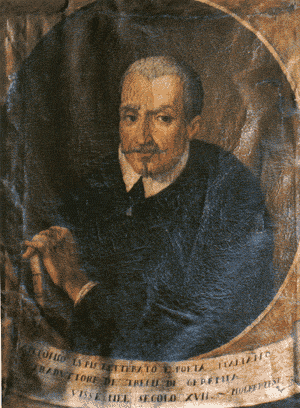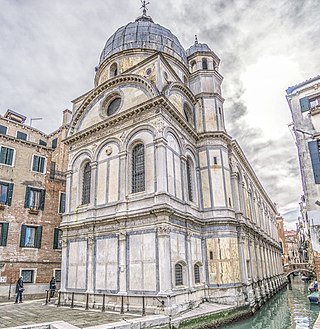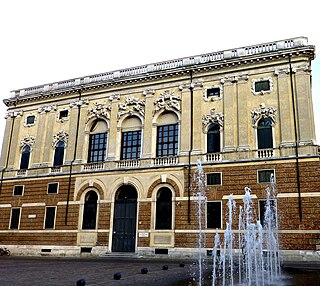Related Research Articles

Vicenza is a city in northeastern Italy. It is in the Veneto region at the northern base of the Monte Berico, where it straddles the Bacchiglione River. Vicenza is approximately 60 kilometres (37 mi) west of Venice and 200 kilometres (120 mi) east of Milan.

Vincenzo Scamozzi was an Italian architect and a writer on architecture, active mainly in Vicenza and Republic of Venice area in the second half of the 16th century. He was perhaps the most important figure there between Andrea Palladio, whose unfinished projects he inherited at Palladio's death in 1580, and Baldassarre Longhena, Scamozzi's only pupil.

Andrea Palladio was an Italian Renaissance architect active in the Venetian Republic. Palladio, influenced by Roman and Greek architecture, primarily Vitruvius, is widely considered to be one of the most influential individuals in the history of architecture. While he designed churches and palaces, he was best known for country houses and villas. His teachings, summarized in the architectural treatise, The Four Books of Architecture, gained him wide recognition.

The House of Contarini is one of the founding families of Venice and one of the oldest families of the Italian Nobility. In total eight Doges to the Republic of Venice emerged from this family, as well as 44 Procurators of San Marco, numerous ambassadors, diplomats and other notables. Among the ruling families of the republic, they held the most seats in the Great Council of Venice from the period before the Serrata del Maggior Consiglio when Councillors were elected annually to the end of the republic in 1797. The Contarini claimed to be of Roman origin through their patrilineal descendance of the Aurelii Cottae, a branch of the Roman family Aurelia, and traditionally trace their lineage back to Gaius Aurelius Cotta, consul of the Roman Republic in 252 BC and 248 BC.

The Palladian villas of the Veneto are villas designed by Renaissance architect Andrea Palladio, all of whose buildings were erected in the Veneto, the mainland region of north-eastern Italy then under the political control of the Venetian Republic. Most villas are listed by UNESCO as part of a World Heritage Site named City of Vicenza and the Palladian Villas of the Veneto.

The Villa Angarano or Villa Angarano Bianchi Michiel is a villa in Bassano del Grappa, Veneto, northern Italy. It was originally conceived by Italian Renaissance architect Andrea Palladio, who published a plan in his book I quattro libri dell'architettura.

Joseph Smith, often known as Consul Smith, was the British consul at Venice from 1744 to 1760. He was a patron of artists, most notably Canaletto, a collector and connoisseur, banker to the British community at Venice, and a major draw on the British Grand Tour. His collection of drawings was bought for George III of Great Britain and forms a nucleus of the Royal Collection of drawings in the Print Room at Windsor Castle.

The Palazzo Porto is a palace in Piazza Castello, Vicenza, northern Italy. It is one of two palazzi in the city designed by Andrea Palladio for members of the Porto family. Only two bays of it were ever built, beginning shortly after 1571. Why the patron, Alessandro Porto, did not continue with the project is not known.

The Villa Trissino is a patrician villa, which belonged to Gian Giorgio Trissino, located at Cricoli, just outside the center of Vicenza, in northern Italy. It was mainly built in the 16th century and is associated by tradition with the architect Andrea Palladio.

Antonio Lupis was a prolific Italian writer of the Baroque period.

Palazzo Civena is a Renaissance palace in Vicenza, Italy, dating to 1540. It was the first palace designed by Andrea Palladio for Giovanni Civena.

Ottone Calderari was an Italian architect and writer of architectural design.

Venetian Renaissance architecture began rather later than in Florence, not really before the 1480s, and throughout the period mostly relied on architects imported from elsewhere in Italy. The city was very rich during the period, and prone to fires, so there was a large amount of building going on most of the time, and at least the facades of Venetian buildings were often particularly luxuriantly ornamented.

City of Vicenza and the Palladian Villas of the Veneto is a World Heritage Site in Italy, which protects buildings by the architect Andrea Palladio. UNESCO inscribed the site on the World Heritage List in 1994. At first the site was called "Vicenza, City of Palladio" and only buildings in the immediate area of Vicenza were included.
Giovan Antonio Rusconi was a Venetian architect, hydraulic engineer, translator and illustrator of Vitruvius.

Francesco Muttoni was an Italian architect, engineer, and architectural writer, mainly active near Vicenza, Italy.
Guido Beltramini is an Italian architectural historian and a curator.
AntonioGaidon (1738–1829), was an architect, urban planner and naturalist.

Minerva between Geometry and Arithmetic is a 1550 fresco fragment, usually attributed to Paolo Veronese but by some art historians to Anselmo Canera or Giambattista Zelotti. It was painted for the Palazzo de Soranzi in Castelfranco Veneto but now in the Palazzo Balbi in Venice.
References
- ↑ Supplemente Perenne alla Nova Enciclopedia Populare Italiana, , Societa L'Unione Tipografica-Editrice, Turin (1873):page 498.